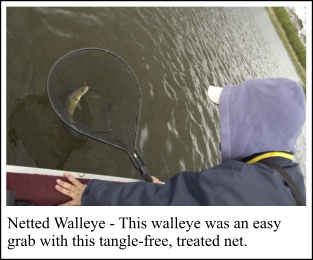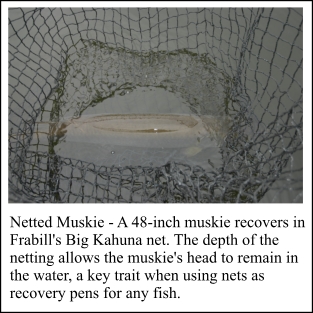A Case for
Quality Nets
By Tim Allard
To me there's nothing wrong with
keeping the occasional fish for the table; however, most of my fish I
release. Catch and release has been a mainstream practice for the past few
decades. Most anglers are familiar with the basics of how to play, handle,
and release a fish to ensure the best chances of post-release recovery.
One tool that will keep catch-and-release procedures safe for you and the
fish is a quality net.
Why a Net?
This year one of my fishing goals is to use a net more often to land fish.
I've got a Frabill Power Catch for landing muskies that I use all the time
for toothy Esox, but when it comes to bass and walleye, I've mainly been a
man of hand landing. I've been changing that this year and there's a few
reasons why.
 First
and foremost is that using a net is a safer way to land fish than by using
your hands. I have yet to have a fish sting me, but I knew someone last
year who ended up with a hook buried in his forearm. He was about to land
an unhook a fish in a manner he'd done dozens, if not hundreds of times.
At the last second the fish jumped, driving a big hook into his arm. I'll
spare you the details of the hospital surgery, but it's left him with
permanent damage. This story (and the hospital X-Ray) planted the seed in
my head to use a net more often this season. First
and foremost is that using a net is a safer way to land fish than by using
your hands. I have yet to have a fish sting me, but I knew someone last
year who ended up with a hook buried in his forearm. He was about to land
an unhook a fish in a manner he'd done dozens, if not hundreds of times.
At the last second the fish jumped, driving a big hook into his arm. I'll
spare you the details of the hospital surgery, but it's left him with
permanent damage. This story (and the hospital X-Ray) planted the seed in
my head to use a net more often this season.
Another reason nets are great is
that a net often has a better landing-percentage than when grabbing a fish
by hand. A quick scoop of the net will result in a landed fish. This also
limits boat-side trashing, reducing overall stress to the fish. So beyond
angler safety, using a quality net is also better for the fish.
The Importance of Quality
Mesh
I want to point out that untreated, knotted nylon nets can be harmful to
fish. These nets can remove a fish's protective slime and damage scales.
This situation gets worse when fish get tangled in the mesh. So, those
old, blue, nylon nets are great if you're keeping fish, but aren't good
tools for releasing them.
Contrasting non-treated nylon, many of today's net manufacturers, like
Frabill or Beckman, have designed various nets with catch and release in
mind. Most netting is either treated nylon or rubber to ensure minimal
removal of slime from a fish. A good net will also be knotless, which
reduces the chance of fish injury. Another great feature to look for in
higher-end models is tangle-proof netting. This material is
 treated
with a coating that will prevent lures from hooking into or tangling the
mesh. Tangle-proof nets are worth the extra cash; you'll get your money
back the first time you use it in freezing temperatures or in rough waves. treated
with a coating that will prevent lures from hooking into or tangling the
mesh. Tangle-proof nets are worth the extra cash; you'll get your money
back the first time you use it in freezing temperatures or in rough waves.
Nets as Pens
A habit becoming increasingly popular with many anglers is using a net as
a recovery pen for fish. You can remove hooks while the fish remains in
the water. If you don't have a live well or if a fish is too big to fit in
the one you do own, using the net as a pen will let you ensure the fish is
fully recovered before releasing it.
There are a variety of options
on today's market when it comes to quality catch-and-release nets, making
it easy to find a model suited for your target species and price range.
Consider using a net more this season. They're a safe and effective way to
land fish and ultimately reduce the chances of injury to both fish and
angler.
Photo Caption Sheet
All Photos by Tim Allard
Netted Muskie - A 48-inch muskie recovers in Frabill's Big Kahuna net. The
depth of the netting allows the muskie's head to remain in the water, a
key trait when using nets as recovery pens for any fish.
Netted Walleye - This walleye was an easy grab with this tangle-free,
treated net.
|


 First
and foremost is that using a net is a safer way to land fish than by using
your hands. I have yet to have a fish sting me, but I knew someone last
year who ended up with a hook buried in his forearm. He was about to land
an unhook a fish in a manner he'd done dozens, if not hundreds of times.
At the last second the fish jumped, driving a big hook into his arm. I'll
spare you the details of the hospital surgery, but it's left him with
permanent damage. This story (and the hospital X-Ray) planted the seed in
my head to use a net more often this season.
First
and foremost is that using a net is a safer way to land fish than by using
your hands. I have yet to have a fish sting me, but I knew someone last
year who ended up with a hook buried in his forearm. He was about to land
an unhook a fish in a manner he'd done dozens, if not hundreds of times.
At the last second the fish jumped, driving a big hook into his arm. I'll
spare you the details of the hospital surgery, but it's left him with
permanent damage. This story (and the hospital X-Ray) planted the seed in
my head to use a net more often this season.  treated
with a coating that will prevent lures from hooking into or tangling the
mesh. Tangle-proof nets are worth the extra cash; you'll get your money
back the first time you use it in freezing temperatures or in rough waves.
treated
with a coating that will prevent lures from hooking into or tangling the
mesh. Tangle-proof nets are worth the extra cash; you'll get your money
back the first time you use it in freezing temperatures or in rough waves.